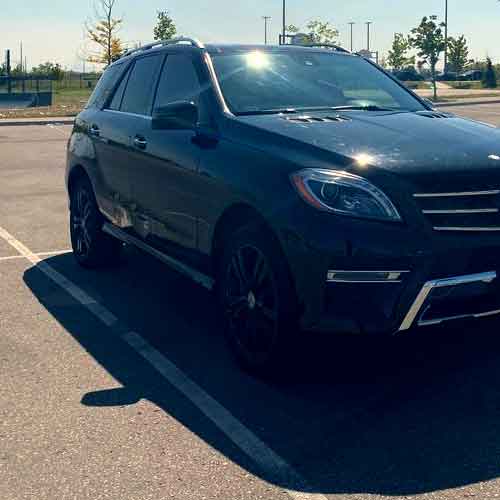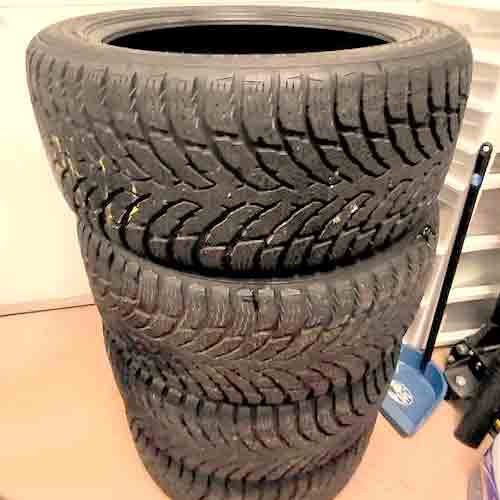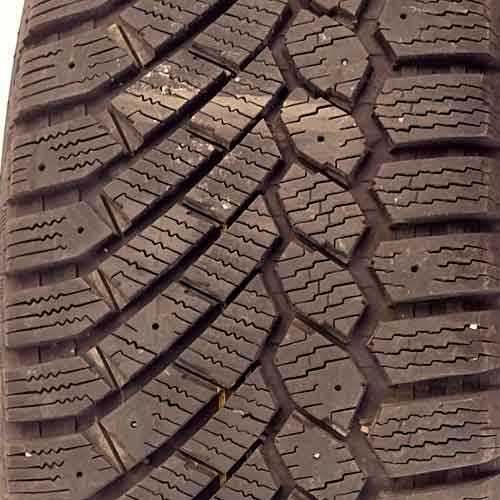The heat is on as Gislaved Nordfrost 200, acclaimed for its revolutionary snow grip technology, confronts Nokian Hakkapeliitta 9, known for its supreme slush performance. Let’s discover which tire wins this icy duel!

Table of Contents
Key Takeaway
The Gislaved Nordfrost 200 excels in:
- Wet Performance: Demonstrated by its superior wet grip due to a thermally adaptive, softer rubber compound.
- Hydroplaning Resistance: The tire efficiently clears out water, through its grooves.
- Overall Grip in Dry Traction: The tire showcased better performance in both directional and lateral grip.
- Impact Comfort Performance: The tire’s design allows for superior vibration dampening.
On the other hand, the Nokian Hakkapeliitta 9 excels in:
- Snow Performance: The tire performs notably better, especially on fluffy snow surfaces, due to its assertive tread pattern and unique interlocking grooves.
- Road Noise: The closed tread design minimizes air particle movement and collision, producing less noise when compared to the Nordfrost.
- Dry Traction Handling: Despite the Nordfrost having better grip, the Hakkapeliitta 9 offers superior handling due to better steering communication abilities.
- Tread life and fuel economy: Being lighter, the Nokian Hakkapeliitta 9 presents a lower rolling resistance which leads to slower tread wear, and better mpg.
- Ice Traction: The tire’s design, including superior biters, V-shaped notches, and abundant siping, facilitates exceptional performance on icy surfaces.
Snow Performance
When it comes to snowy terrain, both tires exhibit stellar performance, performing excellently in a range of snowy conditions.
However, should I be compelled to select a superior performer between these two, my inclination would lean towards the Nokian Hakkapeliitta 9.

This tire has a slight edge, especially when traversing fluffy snow surfaces.
Basically, the features a more assertive tread pattern, which increases the surface area that comes into contact with the snow.
As the tire rolls over fluffy snow, it traps the snow within its unique interlocking grooves and snow traps, allowing the tire to grip the ground better.
This design advantage enhances traction since snow has a higher tendency to stick to other snowflakes than to rubber.
Though the major advantage this tire has is its directional tread pattern, (unlike its counterpart, which offers asymmetric one).
With directional pattern the snow is better scooped out and backwards. And this creates a forward moving force, resulting in superior acceleration.
That’s why the tire’s overall handling on snow is also better, meaning, once the corner is over, the tire has to re-accelerate right? Well, this tire does better, resulting in faster snow laps (as seen on tests).
On the other hand, the Gislaved Nordfrost 200, despite being a strong performer, falls slightly short of matching the competitor’s performance.
Its closely packed lug design doesn’t quite trap and grip the snow as effectively.
Consequently, in the snow performance category, Nokian Hakkapeliitta 9 takes the win.
Comfort Levels
Comfort in a tire is determined mainly by road noise and vibration absorption. Let’s break down these two factors.
Road noise is the sound produced by air particles colliding with the tire’s tread. And here the Nokian Hakkapeliitta 9 scores higher in this area due to its closed tread design, which reduces air particle movement and lessens the force of collision, resulting in less noise.
Basically noise is produced with the impact of air striking the tread. And with less voids, it doesn’t do that easily on Nokian, relatively speaking.
But the tire lacks in another very important ride comfort aspect, and that is vibration dampening.
Now, Hakkapeliitta 9 stiffer rubber, relatively, although offers superior handling and steering response, no doubt, it comes at a cost. And that cost being lacking comfort performance when it comes to dampening road imperfections efficiently.
So overall Nokian is better in terms of noise, while the NordFrost excels in impact comfort performance.
Wet Performance
When driving on wet surfaces, the traction largely depends on the tread design and the rubber compound used in the tire. These factors can dramatically influence how well the tire grips the surface and its resistance to hydroplaning.
Let’s examine both aspects separately for our contenders.
Wet Grip
Both tires of course have generous siping. However, when it comes to wet grip, the Gislaved Nordfrost 200 shines brighter. It has demonstrated quicker stopping and better handling on wet surfaces, as observed in tests.

And here the reason is three-fold:
- Firstly, it employs a more thermally adaptive, softer rubber compound, which allows the tire’s lugs to be more flexible. This increased flexibility facilitates the sipes to create better suction for water particles underneath the tire.
- Secondly, its multi-angled siping contributes to the grip by offering traction in various directions.
The third reason has to do with hydroplaning resistance, let’s discuss it in a separate section.
Hydroplaning Resistance
Hydroplaning is a hazardous driving condition that can occur during wet or rainy conditions. It happens when a layer of water builds up between the tire’s tread and the road surface, causing the tire to lose contact with the road and skid over the water.
To assess the tires’ ability to resist hydroplaning, straight and curved aqua tests were performed.
In these tests, the Gislaved Nordfrost 200 proved superior, particularly during cornering.
And that’s because the tire is able to clear out more water, in comparison.
And that brings us to the third point of why this tire is better overall in terms of wet performance (the “third point” is referring to the “wet grip” section, above).
With more water going out, less is left behind of course. But that means less water is left for sipes to clear off. Since sipes suck up water particles, so rubber can grip the relatively drier surface.
So overall wet performance is better on Nordfrost.
Fuel Economy
The efficiency with which a tire consumes fuel is intricately woven into its road engagement and its structural mass. These elements play a critical role in determining the rolling resistance, a pivotal factor influencing a vehicle’s fuel consumption.
Here, the Nokian distinguishes itself with its lightweight construction and well made directionally aligned ribs.
These features grant it superior aerodynamics, unlike the NordFrost, that comes with asymmetric structure, with more broadly spaced lugs.
Consequently, the Hakkapeliitta offers an effortlessly smooth, fuel-conserving journey, particularly evident during consistent straight paths such as highways.
Ice Traction
Navigating icy terrains demands a tire with an unparalleled grip.
In this icy domain, the Gislaved Nordfrost 200 reigns supreme, as it comes equipped with an arsenal of advanced biters, angled incisions, V-shaped recesses, and a profusion of better interlocking siping, courtesty of its asymmetrical tread.
So you get better ice adherence.
Furthermore, its strategically crafted shoulder lugs ensure grip from myriad angles, further add to that, as they offer efficient braking and maneuverability.
On the flip side, although the Nokian also feature ample siping, they aren’t as flexible to bite, in comparison, with freezing temperatures.
In other words, its tread is not so thermally adaptive compared to its counterpart.
Though the good thing is that both tires offer stud-able lugs, which further improves the overall ice traction.
So overall, Nordfrost tire delivers better performance on icy terrains, in comparison.
Dry Traction
Dry traction is evaluated based on two components: overall grip and handling.
Let’s start with grip.
Overall grip
This grip is two folds, directional and lateral grip.
Directional grip depends on central lugs, and is measured by tire’s braking, while lateral depends on shoulders and is measured by g forces.
Now for the sake of simplicity, the Gislaved Nordfrost 200 stands out in both these performance metrics.
Now although the Nokian Hakkapeliitta offers more rubber contact patch, which should technically result in more grip, the tire still lacks to its counterpart, due to its less effective biters.
Whereas on Nordfrost, you get better interlocking biters, courtesy of its asymmetric design, allows for superior overall grip.
But that does not mean the tire offers better handling. And that’s because handling has to do with grip+tire’s steering communication abilities.
Overall Handling
Now when it comes to handling, the Nordfrost lacks, mainly due to its larger weight. Basically, the tire is more voided up and that combined with greater construction weight, each of its lugs carry more weight stress on them.
So the result? The deformity of its tread. But why is that important here?
Well, with tread deformation, it needs time to be shaped back, and that requires time, which is translated in overall handling times.
In other words, the deformation of the tread leads to oversteer and understeer, resulting in slower steering feedback.
Therefore, when it comes to dry traction, both in terms of directional grip and lateral traction, the Nokian Hakkapeliitta 200 emerges as the winner.
Tread Life
The longevity of a tire’s tread is largely influenced by the rolling resistance, which, in simple terms, is the amount of force resisting the motion of the tire rolling on the surface. A lighter tire will typically have lower rolling resistance, which in turn results in slower tread wear.
In this respect, the Nokian Hakkapeliitta 9 stands out due to its lighter weight, resulting in less strain on the tire lugs as they rub against the road.
Conversely, the NordFrost 200, being heavier and having wider grooves, exerts more pressure on each lug as it rolls. This generates more heat and consequently higher rolling resistance, which accelerates rubber wear.
So, in terms of tread life, the Gislaved Nordfrost 200 is lacking, even though both tires don’t come with any treadwear warranty.